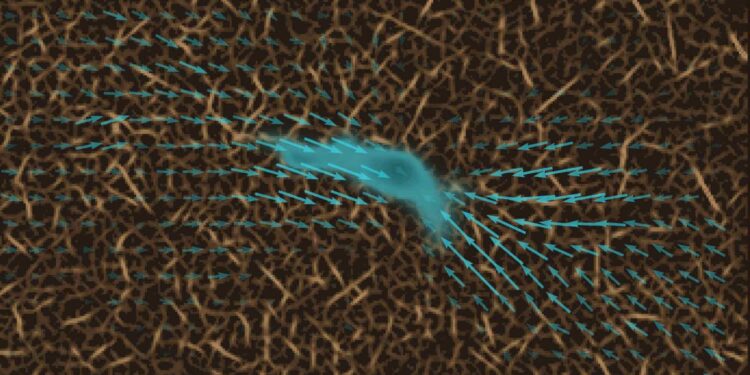Matrix deformation (arrows) around an NK92 immune cell as it migrates through a 3D collagen gel. Credit: Friedrich-Alexander University Erlangen-Nuremberg
To reach their target, for example a tumor, immune cells must leave the bloodstream or lymphatic vessels and migrate through connective tissue. Until now, scientists assumed that immune cells migrated through tissues by constantly changing shape and thus slipping through the smallest pores and openings.
Using a new measurement method, researchers at the Friedrich-Alexander University Erlangen-Nürnberg (FAU) were able to determine that immune cells also exert traction on surrounding tissues in order to pass through particularly narrow pores. Their results were published in the journal Natural physics.
To migrate from point A to point B, immune cells don’t just adjust their shape. Sometimes they attach themselves to their environment and exert forces on that environment in order to pull themselves forward.
“These contractile phases help immune cells move through particularly tight pores,” explains Professor Ben Fabry, FAU chair of biophysics and co-author of the study titled “Dynamic traction force measurements of cells migrating immune cells in a 3D biopolymer matrices.”
“Immune cells are much faster and considerably smaller than most other connective tissue cells. For this reason, we have so far failed to measure such traction forces in immune cells. Our discovery was only made possible thanks to new, considerably faster and more sensitive methods that we have developed and continuously improved in recent years in Erlangen.
Research at the interface of mechanobiology
The new measurement method is 3D tensile force microscopy, a three-dimensional measurement of traction and its impact on tissue. This method even allows scientists to measure the tiny forces of growing nerve cells as well as the forces of larger cellular structures such as tumors.
The interdisciplinary nature of the team which includes researchers in immunology, physics, mechanics and neuroscience shows that the results obtained through 3D traction force microscopy are not only relevant to an isolated discipline, but rather are of significant importance. revolutionary for all sciences related to mechanobiology. .
Professor Fabry emphasizes: “Our discovery that immune cells can create high contraction forces for a brief period is just one example of how this new method will lead to fundamental discoveries. We were also able to show in our study, for example, that growing nerve cells, particularly those called growth cones, can also exert contraction forces on their surroundings, which could prove to be of fundamental importance for the formation of nerve pathways, especially in developing brains.
The research results cannot yet predict future applications. Fabry and his colleagues believe, however, that knowledge about the contraction forces of immune, nerve or cancer cells could contribute to the development of drugs aimed at promoting specific healing processes or suppressing the progression of diseases.
In the meantime, FAU scientists have started work on another study aimed at investigating the precise molecular mechanisms of immune cell migration due to traction forces.
More information:
David Böhringer et al, Dynamic measurements of the traction force of migrating immune cells in 3D biopolymer matrices, Natural physics (2024). DOI: 10.1038/s41567-024-02632-8
Provided by Friedrich-Alexander-University Erlangen-Nuremberg
Quote: New measurement method determines how immune cells actually migrate (October 14, 2024) retrieved October 14, 2024 from
This document is subject to copyright. Except for fair use for private study or research purposes, no part may be reproduced without written permission. The content is provided for informational purposes only.



